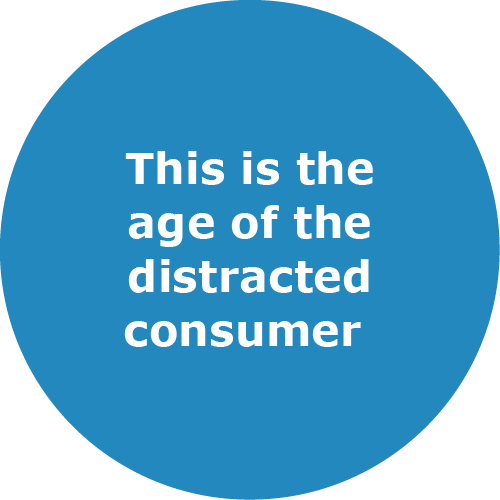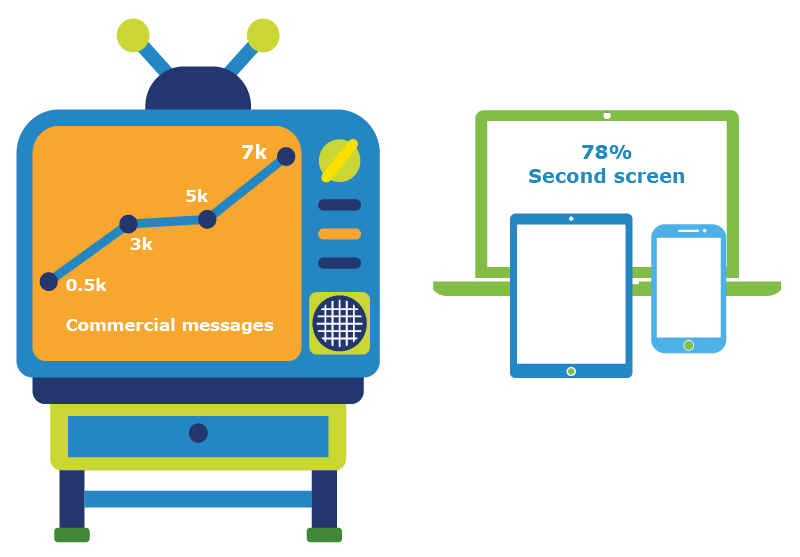
Why Ad Testing is important and why you should be doing it
Welcome to a world where consumers, not advertisers or broadcasters, choose what they watch and where.
Media consumption is evolving and changing over time. Ad testing is simply a way of increasing the chances of an audience actually receiving your message.
The rules are different today.
Testing your advertising campaigns is one way of helping you do just that.
People today can see anywhere from a few hundred commercial messages a day to upwards of a few thousand.
These are the people who today watch multiple screens at once – 78% of US internet users access second screens during TV shows (eMarketer, 2014).

Technology and the proliferation of media devices, platforms and content have changed media consumption forever.
We now live in a world of multiple screens, all competing for our attention.

The problem is that people’s brains aren’t increasing in capacity to deal with the growing number of commercial messages that they are exposed to daily. So it’s time to rethink ad testing.


Have we got your attention?
Let’s find out how to attract the distracted. And how to convert them into your customers.

By “forcing” consumers to look at ads and then asking to assess them, we are missing an important point.
It is all very well to test an ad after it has been noticed, but what if it isn’t noticed in the first place? The far more pressing matter today is not how well an ad performs against brand KPIs after it has been seen, but whether it has the power to break through the clutter to have the opportunity to influence them in the first place.
Will consumers notice or choose to watch your ad on their own free will?
Don’t forget that we live in a world of “pull” media, as dictated by consumers, not the “push” media that was served up by the agencies of yesteryear. For this very reason, our advertising pre-test model contains two elements:
Unforced exposure
This involves consumers being exposed to your ad along with a whole range of other things that are competing for their attention, just as they are in the real world.
It’s up to them whether or not they engage with your ad and for how long they do so. This method enables us to measure the ad’s potential to break through the clutter in a natural enviroment. This helps us to determine whether the brand, product and message featured will stick in the memory of the viewer.
Forced exposure
After full exposure in a manner that is more in keeping up with traditional pre-testing, we’re able to measure ad diagnostics and consumers’ reactions to the ad against key performance indicators.

Testing ads in a natural environment using unforced exposure is the only way to gain the critical insights that marketers need and are missing.
There’s simply no point in having an ad that ticks all the right boxes in terms of consumer response, likability and likelihood to buy if you’re failing to attract consumers’ attention from the outset. You might as well save your advertising dollars.
In the real world, you can’t force consumers to watch ads. It’s time to start living (and testing) in the real world.

With real-world ad testing comes real-world metrics. Attention, Memory, Evaluation and Brand Impact are the four areas that all ad experts need to understand.
The first two metrics relate to breakthrough: Was your ad fully watched? What was the average viewing time? What was the brand recall? And the message recall? How did your ad perform on recognition?
The last two metrics measure ad diagnostics: Was your ad liked? Was it relevant? Was it credible? Did consumers understand it and does it fit with your brand? Are consumers interested in your brand as a result? Are they likely to purchase?



These questions are not necessarily new, but the context in which we are measuring them is radically different from the traditional ways of pre-testing adverts that many research companies still rely on.
Take measuring attention, for example. If consumers are forced to watch an ad, how can we realistically measure attention? This can only be done by passive measurement. We register if and how long a respondent watches an ad.
Similarly, you can’t rely on consumers’ memory of an ad if their viewing experience has been forced. The fact that the memory was formed in this way means the resulting data is inherently skewed.
If advertisers are to obtain a more realistic measure of the likely success of their ads, consumers’ exposure to them cannot be forced. Given the current media environment and an ever-increasing
onslaught of brands vying for consumers’ dwindling attention, break through information based on natural exposure is a necessity for all brands.
Getting a fuller picture through ad testing
So you’ve achieved
break through and
gotten their attention.
Now, how do you make them
like the ad and commit
to making a purchase?
Once consumers have been fully exposed to an ad, we can measure ad evaluation and brand action.
Do consumers like it? How does it make them feel? Will they be stirred into action?
As the statistics about ad failure show, creativity is an art form that is constantly evolving, not a science.
It’s not possible to second guess how consumers will react to any given creative, and for that reason it’s essential that full exposure evaluation is conducted rigorously and systematically.
The final piece of the jigsaw is brand impact – does your ad actually stir consumers into action?
We measure after seeing the ad in full exposure whether the ad increases brand interest and purchase intent.
We know from driver analyses that likeability and relevancy are key for purchase intent.
For consumers to find ads relevant, they need to appeal to them both rationally and emotionally.


The point of pre-testing has long been to de-risk investment of advertising money (ROI).
With the right insights, ad planners and marketers can create campaigns that are strongly positioned for success and enter even the most crowded markets with a certain degree of confidence.
But experts in both the advertising and research industries must not be content to commit to campaigns without the deep understanding about how an ad is likely to fare.
Digital clutter is increasing by the nanosecond and that trend will not be reversed.
Whether we like it or not, consumers are distracted and disengaged. The pressure is on marketers to persuade consumers to view their ads.
In this context, the only rational response is to test ads in a realistic environment and agree that break through is every bit as important as response, if not more so.
Learn more
To understand more about ad testing, visit www.metrixlab.com or contact us.
About MetrixLab
MetrixLab is a fast-growing global market research and insights company that’s challenging the status quo of insights. By blending evolving technology with passionate experts, MetrixLab helps global and local brands to drive more impact, and forges partnerships to drive sustainably equitable growth. From creative testing to brand tracking, and packaging to e-commerce optimization, MetrixLab’s range of solution suites adapts to fit all types of budgets, timelines and business needs.
Active in more than 90 countries, MetrixLab is a proud partner to more than half of the world’s top 100 brands and part of the Macromill Group.
© Perfectly Possible Designs Ltd
